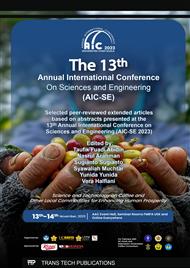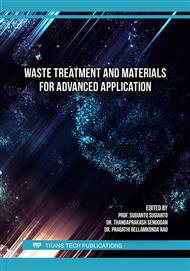p.49
p.57
p.67
p.83
p.99
p.111
p.119
p.125
p.135
Performance Analysis of a Diesel Generator Using Dexlite Mixed Fuel with Bio-Oil Produced from Coffee Grounds Pyrolysis
Abstract:
Coffee grounds are an abundant biomass rarely used and often thrown away for nothing. On the other hand, pyrolysis is an alternative technology for utilizing biomass such as coffee grounds into biochar, syngas, and bio-oil. The bio-oil resulting from pyrolysis can then be mixed with dexlite in a 1:1 ratio, which is then called B50. This paper aims to analyze the performance of a Diesel generator driven by a motor fueled by Dexlite (a Diesel fuel variant that has a minimum CN of 51 and contains a maximum of 1200 ppm sulfur) and a mixture of bio-oil resulting from the pyrolysis of coffee grounds at a temperature of 500 °C with Dexlite (B50), with variations in load power of 300 Watt, 1100 Watt, and 1300 Watt. Generator set performance analysis includes effective power, torque, specific fuel consumption, generator efficiency, and exhaust emissions. At a load of 1300 W with a rotation of 1600 rpm, the maximum effective power obtained is the same, whether the generator is fueled with dexlite or B50, around 1,440 kW. The maximum torque value for dexlite and B50 fuel is 8.6 Nm. The maximum specific fuel consumption (SFC) for dexlite fuel at a load of 300 W at 1600 rpm is 645.25 g/kWh. The maximum air and fuel ratio (AFR) is on the B50 with a load of 300 W at 2000 rpm, which is 1:47. The maximum thermal efficiency is at the B50 at 1600 rpm, around 66.6%. The maximum generator efficiency is 48% with dexlite fuel and B50. Regarding exhaust gas analysis, the maximum CO exhaust emission level is 475 PPM on dexlite. In contrast, the maximum H2S level is 347 PPM on Dexlite, whereas the maximum O2 concentration is 20.6% when the generator operates on B50. The analysis found that the performance of diesel generator engines with B50 fuel was better than pure Dexlite.
Info:
Periodical:
Pages:
135-141
Citation:
Online since:
December 2024
Authors:
Keywords:
Price:
Сopyright:
© 2024 Trans Tech Publications Ltd. All Rights Reserved
Share:
Citation:



